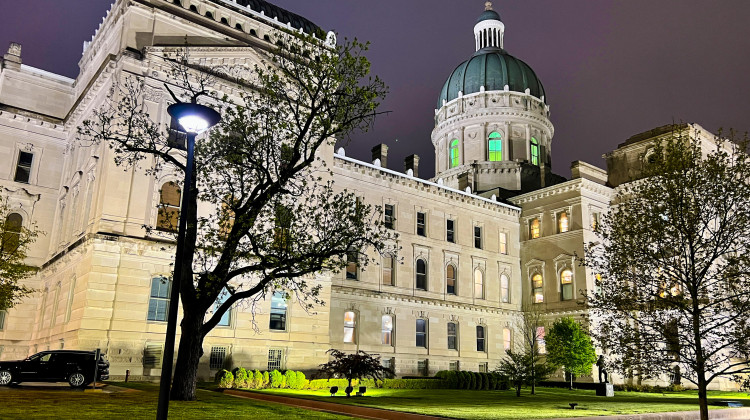
In Indiana, 20 percent fewer girls ages 15-19 became pregnant from 2010 to 2013, according to data from the Indiana State Department of Health.
Photo courtesy Janine (Flickr)Abortion rates are on the decline across the country.
An Associated Press survey this week revealed abortion rates on average dropped 12 percent nationally.
In Indiana the decline was even more dramatic.
In 2010, the state saw 10,031 abortions, according to the Indiana State Department of Health. In 2013, the year with the most recent data, there were 8,027. That’s a 20 percent decline.
Likewise the teen pregnancy rate has also dropped 20 percent. In 2010 there were 37.5 births per 1,000 teen girls. In 2013, the number was 30.3 per 1,000.
Interpretation of that data varies widely, often depending on whether a person is pro-life or pro-choice.
Planned Parenthood of Indiana CEO Betty Cockrum believes the statistics show girls are less likely to get in the position where they have to choose between an abortion or giving birth, and she credits better access to contraceptives.
“It’s clear that the Affordable Care Act, with the introduction of birth control without copays, is making a difference,” she says.
Cockrum admits the Affordable Cara Act, aka Obamacare, hasn’t been around for long, so there might also be other factors playing into the decline. She says it could also be that if the drop is this stark early on, the abortion rate will likely continue to drop as more people take advantage of the Affordable Care Act’s benefits.
One of the other factors contributing to the decline could be that Hoosiers are crossing into neighboring states where there are fewer restrictions on abortions.
Take Michigan for example. That state’s abortion rate actually increased 18 percent from 2010 to 2013. Health officials say the number of non-residents getting abortions there doubled over the last year.
But pro-life advocates cite other reasons for the decline, including new state laws.
“One category was consent information for women,” says Sue Swayze, a spokeswoman for Indiana Right to Life. “In Indiana, for example, prior to 2011, we didn’t have anything in writing that she had to get, so in 2011 we upgraded our law to give her some information in writing much like you and I would get before we get any medical procedure.”
That included giving women the option of viewing their ultrasound.
“In my day, I remember when Roe [v. Wade] came in and we thought it might be a blob of tissue or something,” Swayze says. “But today’s generation, they’ve grown up with ultrasounds. They don’t know any different. It’s something we share, we put on Facebook, so social media and technology like ultrasounds have shown that that’s a baby.”
Instead of implementing more laws focused on abortions themselves, some health experts are advocating for more sex education.
“I would love to see fewer and fewer abortions,” says Kathryn Brown, a health and sexuality educator at the Indiana University Student Health Center. “I would love to see fewer and fewer women go through what for most of them is probably an agonizing decision that stays with them for many months or years.”
The way to do that, she says, is to make young women aware of new contraceptives.
“We have so many good, very effective, long-acting reversible contraceptives now,” she says. “Meaning you take it and it can last for years–IUDs and implants that give not 100 percent, but nearly 100 percent protection. Do these young people know about these methods? I don’t know.”
Schools in Indiana aren’t required to teach sex education and when they do, they don’t have to teach about contraceptives. Instead, the state mandates they teach abstinence.
Planned Parenthood’s Betty Cockrum says that’s not working.
“Here in Indiana, there’s clearly no comfort with the whole conversation around sex ed, and that takes its toll,” she says. “It takes its toll on young people’s behaviors, and it takes its toll on how many young women are giving birth and how that contributes to the cycle of poverty.”
Another organization that is trying to move beyond the abortion debate is the All Options Pregnancy Resource Center in Bloomington.
The center’s mission is in its name–to present women with all of their options. It provides free pregnancy tests, peer counseling, diapers and baby clothes, referrals for HIV tests, and, unlike many crisis pregnancy centers, abortion funding.
All Options Pregnancy Center Director Shelly Dodson knows that last service is controversial, but she says helping women know what’s available to them throughout their pregnancy and meeting people where they are is more effective than fighting over abortions.
“We want to be able to have these conversations that move beyond pro-life and pro-choice and how do we support people in all their experiences,” Dodson says. “It’s not about whether abortion is right or wrong. It’s about how we can support all of their needs.”
 DONATE
DONATE





 View More Articles
View More Articles

 Support WFYI. We can't do it without you.
Support WFYI. We can't do it without you.